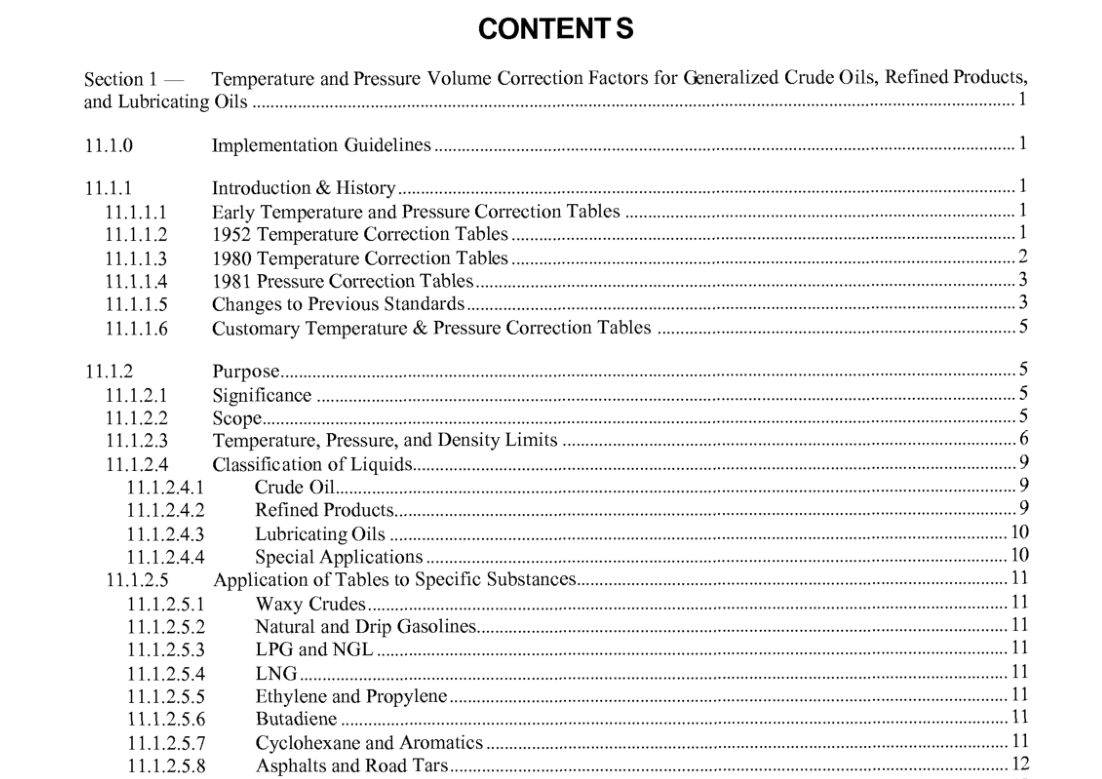API MPMS 11.1 pdf download

API MPMS 11.1 pdf download.Manual of Petroleum Measurement Standards Chapter I I-Physical Properties Data
11.1.1 Introduction 8, History
The density and therefore the volume of hydrocarbons is sensitive to temperature and pressure. Volume Correction Factors (VCFs) are used to correct observed volumes to equivalent volumes at a standard temperature and pressure. These standard, or base, conditions serve as a way to use volumetric measures equitably in general commerce. This Standard establishes a procedure for crude oils, liquid refined products, and lubricating oils by which density measurements taken at any temperature and pressure can be corrected to an equivalent density at the base conditions. The Standard also provides a method for making a conversion to alternate base temperatures. The volume correction factors, in their basic form, are the output of a set of equations derived from and based on empirical data relating to the volumetric change of hydrocarbons over a range of temperatures and pressures. Traditionally, the factors have been listed in a tabular format called the Petroleum Measurement Tables. In order to introduce this document and the work that serves as its foundation, a short history of these Tables is warranted.
11.1.1 Correction factors to account for the thermal expansion of liquid hydrocarbons were first formally developed in 1916 by the National Bureau of Standards (United States) under ircular No. 57. These data were based on density and temperature pairs documented in the National Bureau of Standards (NBS) Technologic Paper No. 77. Circular No. 57 was superseded in 1924 by Circular No. C154 which in turn was superseded by a more widely known Circular C410, in 1936. By 1945 The Institute of Petroleum (IP) was publishing the Tables for Measurement of Oil in British units. Early Temperature and Pressure Correction Tables The compressibility standard (API Standard 1 101 , Appendix By Table 11) for hydrocarbons in the O to 90” API gravity ranges was developed in 1945 by Jacobson, et al. It was based on limited data obtained mostly on pure compounds and lubricating oil type materials. Standard 1101 was developed without the aid of a mathematical model.11 .I .I .2 1952 Temperature Correction Tables In 1952 the British and the American temperature correction factor tables were joined together and made available in three units of measure: US units, British (Imperial) units, and metric units. These tables were called The Petroleum Measurement Tables and were published jointly by the American Society for Testing and Materials (ASTM) and the IP. These tables are commonly referred to as the 1952 Tables, or “Blue Book Tables.”The 1 952 Tables contained many sets of correction and conversion factor tables used in the measurement of hydrocarbon liquids. The tables were numbered one through fifty-eight, each dealing with a particular conversion of units, correction of density, or correction of volume. This 1 952 document reflects the evolution of the correction factor tables for the correction of density or gravity to base temperature, and the correction of volume to base temperature against density at base temperature. The following shows many of the 1 952 Tables which dealt with density and volume correction. These Tables were available in two volumes, US and metric versions.11 .I .I .3 1980 Temperature Correction Tables In 1 974 the API started an initiative to re-confirm the temperature correction factor tables. This resulted in a major work program of density measurements made by the National Bureau of Standards under contract to the API. The effort culminated in re-writing major sections of the 1 952 Tables to produce new density and volume correction tables, commonly referred to as the 1 980 Tables. Refer to Appendix A for more information on this work. The 1 980 Tables separated the density and volume correction tables into two major commodity groups: crude oils and refined products. Tables were also produced for a third grouping know as “special applications.” A letter designation was added to the table numbering system devised in 1952: “A” for crude oil, “B” for refined products, and “C” for special applications. The table designations established are shown in the following table.









